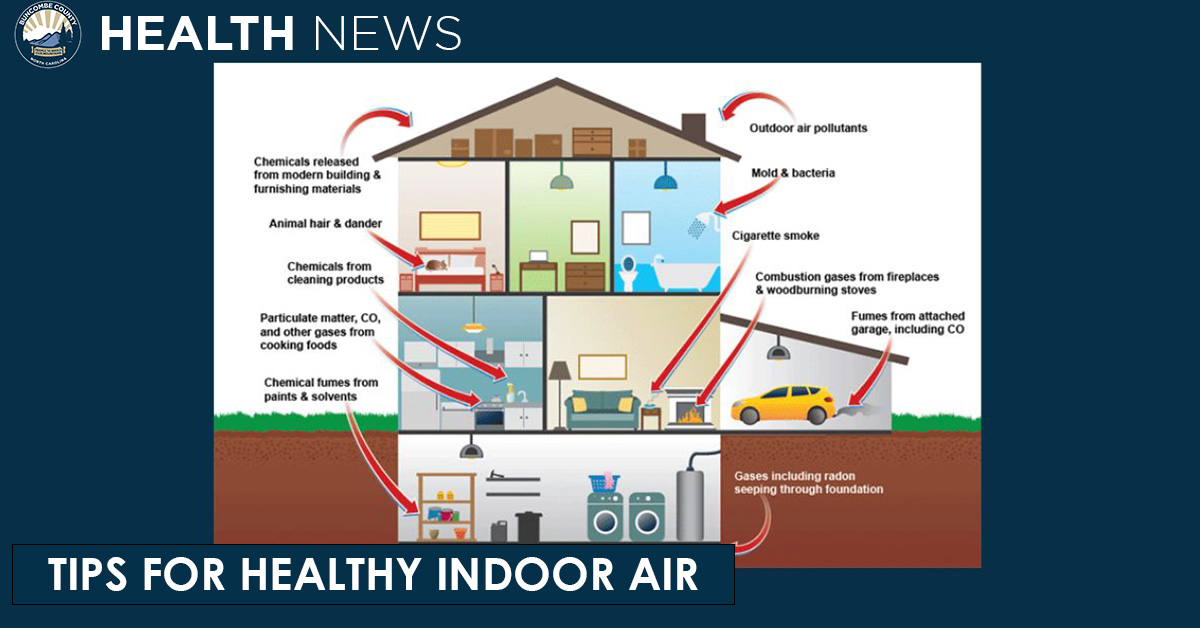This news item expired on Wednesday, May 1, 2024 so the information below could be outdated or incorrect.

While we often think about air pollution as an outdoor issue, indoor air quality is just as important and can have serious impacts to the health of children in the home. Asheville-Buncombe Air Quality is an important part of monitoring and regulating our local air quality, inside and outside. As we move into cooler weather and more time spent inside, AB Air Quality wants to remind families of the sources of unhealthy air quality and how to mitigate these threats.
Children are often more vulnerable to pollutants than adults due to differences in behavior and biology, and these differences can lead to greater exposure or susceptibility. For this reason, children in overburdened and highly exposed communities may suffer from a reduced ability to recover from harmful environmental exposures, impacting children in low-income communities, as well as children in communities underserved by education, healthcare, and housing.
Ground level ozone and fine particles are the main pollutants of concern outdoors which is why we suggest avoiding backyard burning and checking the air quality forecast to address outdoor air quality concerns for children.
Indoor air quality is very important since it is estimated that most of us spend at least 90% of our time indoors, where concentrations of pollutants can build up to levels higher than outdoors. Radon, secondhand smoke, and sources of lead are some of the main threats to health indoors.
Causes of poor indoor air quality are usually caused by the following sources:
- Radon: Radon is a radioactive gas that is formed in the soil. It can enter indoors through cracks and openings in floors and walls that are in contact with the ground. It is the leading cause of lung cancer among nonsmokers, and the second leading cause of lung cancer overall. Testing for radon is recommended and simple test kits are available online.
- Secondhand Smoke: Secondhand smoke comes from burning tobacco products. It can cause cancer and serious respiratory illnesses. Children are especially vulnerable to secondhand smoke. It can cause or worsen asthma symptoms and is linked to increased risks of ear infections and Sudden Infant Death Syndrome (SIDS).
- Combustion Pollutants: Combustion Pollutants are gases or particles that come from burning materials. In homes, the major source of combustion pollutants is improperly vented or unvented fuel-burning appliances such as space heaters, woodstoves, gas stoves, and water heaters. The U.S. Consumer Product Safety Commission (CPSC) recommends that every home have carbon monoxide alarms on each level outside each sleeping area. In addition, CPSC urges consumers to have an annual professional inspection of all fuel-burning appliances including furnaces, stoves, fireplaces, clothes dryers, water heaters, and space heaters to detect deadly carbon monoxide leaks.
- Volatile Organic Compounds such as paints, cleaning supplies, and building materials evaporate into the air when these products are used or sometimes even when they are stored. Volatile organic compounds irritate the eyes, nose and throat, and cause headaches, nausea, and damage to the liver, kidneys, and central nervous system. Some of them can cause cancer.
- Asthma Triggers: Asthma triggers are commonly found in homes, schools, and offices and include mold, dust mites, secondhand smoke, and pet dander. A home may have?mold?growing on a shower curtain,?dust mites in pillows, blankets or stuffed animals,?secondhand smoke in the air, and?cat and dog hairs on the carpet or floors. Other common asthma triggers include some foods and pollutants in the air.
- Lead: Children can be tested for lead by their doctor or health care provider. Test your home for lead based paint hazards if it was built before 1978.
Learn How to?Care for Your Air: A Guide to Indoor Air Quality: Some effective air quality improvement steps can go a long way to care for your family’s air.
- Controlling the sources of pollution: Usually, the most effective way to improve indoor air is to eliminate individual sources or reduce their emissions.
- Ventilating: Increasing the amount of fresh air brought indoors helps reduce pollutants inside. When weather permits, open windows and doors, or run an air conditioner with the vent control open. Bathroom and kitchen fans that exhaust to the outdoors also increase ventilation and help remove pollutants. Always ventilate and follow manufacturers’ instructions when you use products or appliances that may release pollutants into the indoor air.
- Changing filters regularly:?Central heaters and air conditioners have filters to trap dust and other pollutants in the air. Make sure to change or clean the filters regularly, following the instructions on the package.
- Adjusting humidity: The humidity inside can affect the concentrations of some indoor air pollutants. For example, high humidity keeps the air moist and increases the likelihood of mold. Keep indoor humidity between 30 and 50 percent. Use a moisture or humidity gauge, available at most hardware stores, to see if the humidity in your home is at a good level. To increase humidity, use a vaporizer or humidifier, but be sure to clean it regularly. To decrease humidity, open the windows if it is not humid outdoors. If it is warm, turn on the air conditioner or adjust the humidity setting on the humidifier.
Air quality can often go unnoticed; however, air pollution can be a visible concern and is a serious health risk to communities. For more information, visit this website.